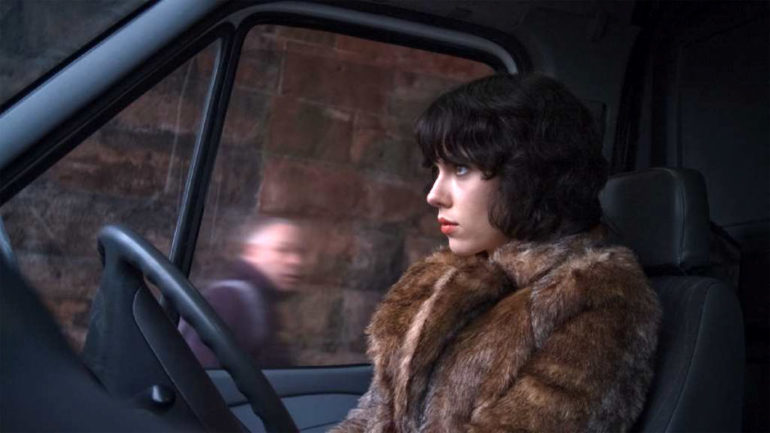Under The Skin: it’s less a title and more a declaration. It aims to burrow there; it slips beneath flesh and bone to niggle at your core long after the film ends. Many films are described as ‘haunting’, but Under The Skin will genuinely prey on your subconscious. How could it not? It’s full of images to seduce, unsettle and occasionally horrify. Like so many sentences one could say about this film, it’s meant in the best possible sense.
Michael Faber’s 2000 source novel was praised for its satirical take on environmental issues and gender politics. The latter is accentuated more in the film, but not in any seedy or overly erotic way. Under The Skin may feature Scarlett Johansson stripping, but any hint of eroticism swiftly gives way to deep unease and darkness. Johansson plays an unnamed humanoid alien dispatched to Earth to lure and trap punters for reasons that are initially unknown. Hints are offered as to what her mission is, but director Jonathan Glazer (making his first film since 2004’s Birth) needs to explain relatively little; he continually fills the viewer with dread, and that sickly feeling is enough. She’s deposited outside Glasgow, sporting a human disguise. Given a van and some decidedly secondhand clothing, she sets off on her mission. The first half of Under The Skin combines the cool detachment of Johansson’s performance with some cinema verité-esque techniques to chilling effect. The camera presents us with this interplanetary visitor’s eye-view, scouring Glasgow’s streets for potential victims. Capturing real people going about their daily business in broad daylight gives proceedings a decidedly voyeuristic feel. Like the alien, the camera glides along surreptitiously, but full of intent and curiosity. She blurs the lines between alien and human as Glazer blurs the line between cinema and reality; the non-actors used here (allegedly without their knowledge, in some cases) bring this outsider into sharp focus. Scarlett Johannson’s beauty sets her apart; next to Glaswegian grunge, she’s alien in every sense of the word.
As our lead seduces her victims to their demise (The film’s most memorable sequences sees her horny quarries wade into a black pool of liquid death), so Under The Skin wraps itself around the viewer with material and techniques they’ve seen before, only to shock with moves and combinations to surprise at every turn. Under The Skin sounds like schlock in the vein of Species, but it automatically gets elevated when it’s transplanted into a landscape befitting Ken Loach. Then throw into the mix some Kubrick-esque cool (The few purely sci-fi settings recall 2001), some Hitchcockian tension and a dash of Lynchian oddity (One plot strand nods to The Elephant Man) to accentuate that extra-terrestrial flavour. The remarkable thing about Under The Skin is not how many influences it can cite, but that the film never gets buried under these influences. It has multiple inspirations and yet it stands out as its own unforgettable entity. Plotwise, comparisons can be drawn to Roeg’s The Man Who Fell To Earth, but Under The Skin flips that film’s conceits on their head. The alien is the source of malevolence here, and human contact is all physical; it could scarcely be emotional or relatable, after all. Johansson’s alien is a necessarily lonely creature, and Under The Skin is a hauntingly lonely film. Rural Scotland, all mist and ruggedness, is at once a beautiful and foreboding landscape. She may be an alien, but she’s the one on the perilous space mission to a different and dangerous world.
Glazer’s claustrophobic lensing in the first half of the films gives way to slightly less stylised work in the second, as the experimental feel that defines the film’s opening scenes gives way to plot beats. Still, the transition is no bad thing; whilst there may be a little less tension to the second half, there is still a fundamental sense of foreboding. Where can this film go? How long can the visitor maintain her pretense? You’ll be kept guessing by Johansson’s poker-face and the absolutely phenomenal sound design. When not being overwhelmed by screeching digitised strings (The assured work of composer Mica Levi is hard forgotten), the soundscape vibrates with hums and dissonance. Every element of Under The Skin’s production is designed with disturbance in mind. The film opens with what appears to be a close-up of a human eye (or at least what might become a human eye), but when that which purports to be human may not be so, how can we trust it? At the core of this mystery is Johansson, guarding her character’s secrets until her lonely task takes its toll. Between this, Don Jon and Her, 2013 may well be her watershed year. She can be vocal, still, alluring and deceptive, and better roles should start to come her way.
There is little point in denying that Under The Skin is doomed/destined to divide audiences. Selling this as a film in which Scarlett Johansson takes her clothes off will simply attract an audience who may not be ready for it. Under The Skin is coolly, chillingly brilliant, unwilling to be pinned to any given set of expectations. Then again, that’s what makes it so memorable. By the time its eerie ending rolls around, Under The Skin has slipped into the depths of the mind like one of the alien’s victims slips under an abyss to their deaths. Be warned; it will not leave there for a long time afterwards.

